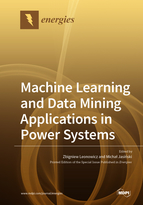Machine Learning and Data Mining Applications in Power Systems
A special issue of Energies (ISSN 1996-1073). This special issue belongs to the section "F: Electrical Engineering".
Deadline for manuscript submissions: closed (28 October 2021) | Viewed by 42453
Special Issue Editors
2. Faculty of Electrical Engineering and Computer Science, VSB-Technical University of Ostrava, 708-00 Ostrava, Czech Republic
Interests: signal analysis; advanced signal processing methods; renewable energy; ecology
Special Issues, Collections and Topics in MDPI journals
2. Faculty of Electrical Engineering and Computer Science, VSB-Technical University of Ostrava, 708-00 Ostrava, Czech Republic
Interests: power quality; electrical power engineering; renewable energy technologies; machine learning; clean energy; multi-energy systems; data mining; sustainable development
Special Issues, Collections and Topics in MDPI journals
Special Issue Information
Dear colleagues,
This Special Issue is intended as a forum for advancing research and for applying machine learning and data mining in order to facilitate the development of modern electric power systems, grids and devices, smart grids, and protection devices, as well as for developing tools for more accurate and efficient power system analysis.
Conventional signal processing is not more adequate for extracting all of the relevant information from distorted signals through filtering, estimation, and detection in order to facilitate decision making and to control actions. Machine learning algorithms, optimization techniques and efficient numerical algorithms, distributed signal processing, machine learning, data mining statistical signal detection, and estimation may help in solving contemporary challenges in modern power systems. The increased use of digital information and control technology can improve the grid’s reliability, security, and efficiency; dynamic optimization of grid operations; demand response; incorporation of demand-side resources and integration of energy-efficient resources; distribution automation; and integration of smart appliances and consumer devices. Signal processing offers the tools needed to convert measurement data to information and to transform information into actionable intelligence.
The expected outcomes will be a grid with improved situation awareness, faster and more accurate control actions to detect and isolate faults, improved assurance of power quality, and higher levels of energy efficiency.
Prof. Dr. Zbigniew Leonowicz
Dr. Michał Jasinski
Guest Editors
Manuscript Submission Information
Manuscripts should be submitted online at www.mdpi.com by registering and logging in to this website. Once you are registered, click here to go to the submission form. Manuscripts can be submitted until the deadline. All submissions that pass pre-check are peer-reviewed. Accepted papers will be published continuously in the journal (as soon as accepted) and will be listed together on the special issue website. Research articles, review articles as well as short communications are invited. For planned papers, a title and short abstract (about 100 words) can be sent to the Editorial Office for announcement on this website.
Submitted manuscripts should not have been published previously, nor be under consideration for publication elsewhere (except conference proceedings papers). All manuscripts are thoroughly refereed through a single-blind peer-review process. A guide for authors and other relevant information for submission of manuscripts is available on the Instructions for Authors page. Energies is an international peer-reviewed open access semimonthly journal published by MDPI.
Please visit the Instructions for Authors page before submitting a manuscript. The Article Processing Charge (APC) for publication in this open access journal is 2600 CHF (Swiss Francs). Submitted papers should be well formatted and use good English. Authors may use MDPI's English editing service prior to publication or during author revisions.
Keywords
- machine learning
- data mining
- smart grids
- power system control
- power system protection
- power flow
- energy management
- renewable energy
- demand-side management
- demand response
- load scheduling
- uncertainty estimation
- power balancing







